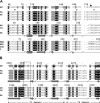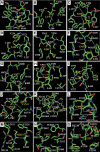Identification of 31 novel mutations in the F8 gene in Spanish hemophilia A patients: structural analysis of 20 missense mutations suggests new intermolecular binding sites
- PMID: 18184865
- PMCID: PMC2275016
- DOI: 10.1182/blood-2007-08-108068
Identification of 31 novel mutations in the F8 gene in Spanish hemophilia A patients: structural analysis of 20 missense mutations suggests new intermolecular binding sites
Abstract
Hemophilia A (HA) is an X-linked bleeding disorder caused by a wide variety of mutations in the factor 8 (F8) gene, leading to absent or deficient factor VIII (FVIII). We analyzed the F8 gene of 267 unrelated Spanish patients with HA. After excluding patients with the common intron-1 and intron-22 inversions and large deletions, we detected 137 individuals with small mutations, 31 of which had not been reported previously. Eleven of these were nonsense, frameshift, and splicing mutations, whereas 20 were missense changes. We assessed the impact of the 20 substitutions based on currently available information about FV and FVIII structure and function relationship, including previously reported results of replacements at these and topologically equivalent positions. Although most changes are likely to cause gross structural perturbations and concomitant cofactor instability, p.Ala375Ser is predicted to affect cofactor activation. Finally, 3 further mutations (p.Pro64Arg, p.Gly494Val, and p.Asp2267Gly) appear to affect cofactor interactions with its carrier protein, von Willebrand factor, with the scavenger receptor low-density lipoprotein receptor-related protein (LRP), and/or with the substrate of the FVIIIapi*FIXa (Xase) complex, factor X. Characterization of these novel mutations is important for adequate genetic counseling in HA families, but also contributes to a better understanding of FVIII structure-function relationship.
Figures





References
-
- White GC, 2nd, Rosendaal F, Aledort LM, et al. Definitions in hemophilia: recommendation of the scientific subcommittee on factor VIII and factor IX of the scientific and standardization committee of the International Society on Thrombosis and Haemostasis [letter]. Thromb Haemost. 2001;85:560. - PubMed
-
- Fay PJ, Jenkins PV. Mutating factor VIII: lessons from structure to function. Blood Rev. 2005;19:15–27. - PubMed
-
- Graw J, Brackmann HH, Oldenburg J, Schneppenheim R, Spannagl M, Schwaab R. Haemophilia A: from mutation analysis to new therapies. Nat Rev Genet. 2005;6:488–501. - PubMed
Publication types
MeSH terms
Substances
LinkOut - more resources
Full Text Sources
Medical
Molecular Biology Databases
Miscellaneous

